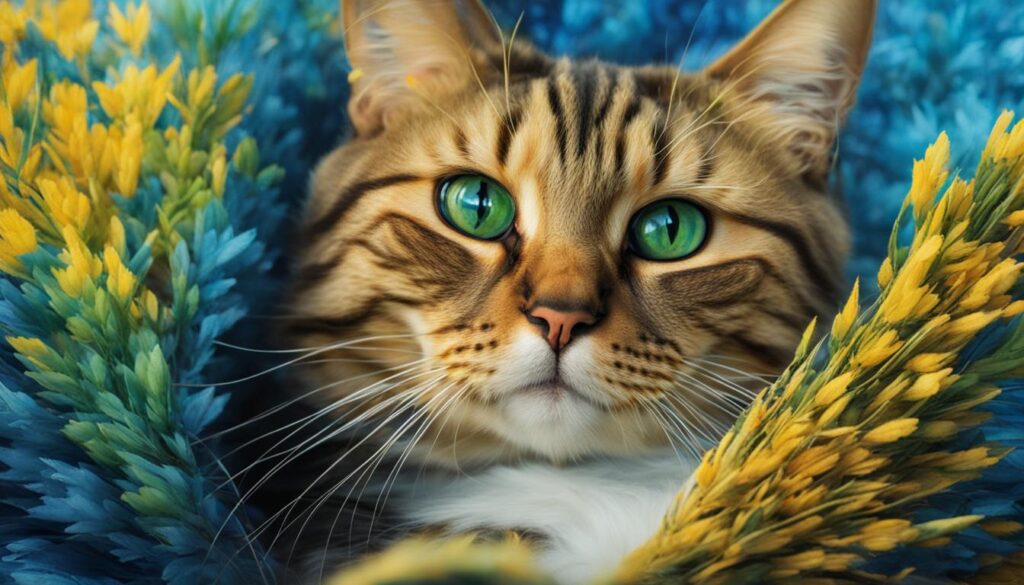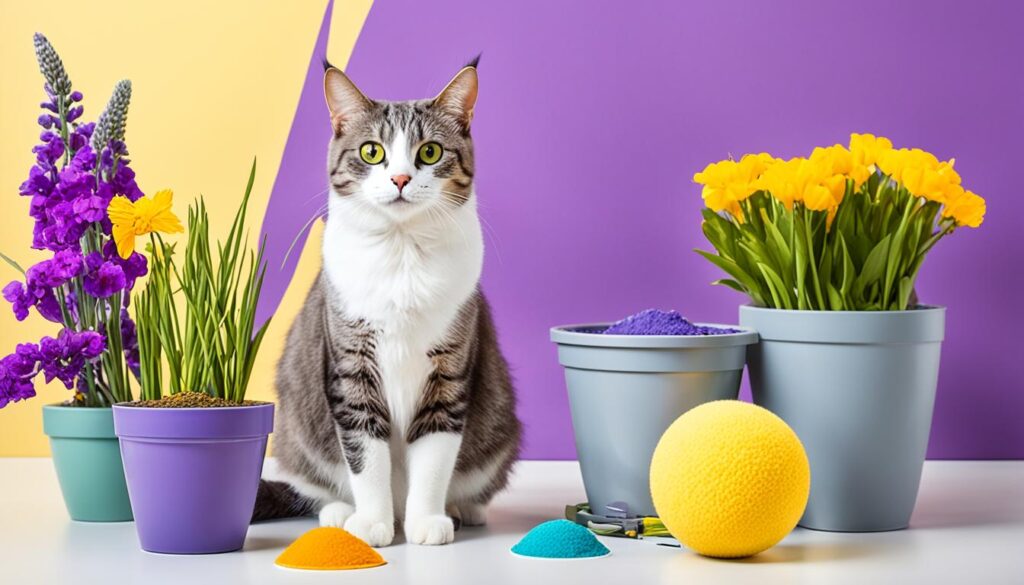What Colors Can Cats Really See?: Did you know that cats cannot see certain colors that humans can? It’s true! Our feline companions have a unique color perception that differs from our own. Understanding how cats see the world can offer fascinating insights into their visual experiences and enhance our bond with them.
What Colors Can Cats Really See?: Key Takeaways
- Cats have a limited range of color perception and cannot see red, brown, and orange.
- They have fewer cones in their eyes than humans, which affects their ability to perceive color.
- Cats see best in dim light and have excellent night vision due to their ro cells.
- They have binocular vision and a vertical pupil, allowing them to see clearly in any light.
- Understanding a cat’s color vision can help in creating a stimulating environment and selecting visually engaging toys for them.
How Does a Cat’s Vision Compare to a Human’s?
When it comes to vision, cats have some fascinating differences compared to humans. These distinctions play a crucial role in how cats perceive the world around them.
Cats possess a remarkable ability to see in low light conditions, making them excellent hunters, especially during dusk and dawn. Their eyes contain a higher concentration of rod cells, specialized photoreceptor cells that are highly sensitive to dim light. This adaptation allows cats to have superior night vision compared to humans.
However, in terms of visual acuity, cats are more near-sighted than humans. Their eyes are designed to focus on objects that are relatively close to them, which is essential for effectively capturing prey. On the other hand, their ability to see distant objects with clarity is somewhat limited compared to humans.
Cats have a wide field of vision due to the placement of their eyes on the sides of their heads. This arrangement enables them to have a broader visual perspective and detect movement from various angles. However, their binocular vision, the ability to perceive depth and distance accurately, is compromised as a trade-off. Cats rely more on motion rather than depth perception, which explains their extraordinary agility when pursuing fast-moving targets.
It’s important to note that while cats excel at tracking and capturing moving objects, their ability to see motionless objects is comparatively poorer. This is because their vision is finely tuned to focus on things in motion rather than stationary items.
To further understand the differences between cat and human vision, let’s take a look at the following table comparing some key aspects:
| Aspect | Cat Vision | Human Vision |
|---|---|---|
| Color Perception | Can see some colors but have a more limited range compared to humans | Can perceive a wide spectrum of colors |
| Ability to See in Low Light | Excellent night vision due to a higher concentration of rod cells | Less adapted to seeing in dim light compared to cats |
| Depth Perception | Diminished depth perception due to the placement of eyes on the sides of the head | Superior depth perception, allowing for accurate judgment of distances |
| Field of Vision | Wider field of vision but compromised binocular vision | Narrower field of vision but enhanced binocular vision |
As we can see, cats and humans have distinct differences in their visual capabilities. While humans have a more comprehensive color range and superior depth perception, cats possess remarkable night vision, a wider field of vision, and exceptional agility in tracking moving objects.
Understanding these differences not only enriches our knowledge of feline physiology but also helps us create a more engaging and stimulating environment for our beloved feline companions.
The Science of Cat Color Vision
Cats have trichromatic vision, meaning they have three types of cones in their eyes that allow them to perceive certain colors. However, they have fewer cones than humans, giving them a more limited range of color perception. While cats can see shades of blue and gray, they cannot see colors on the red end of the spectrum.
Unlike humans, cats’ color vision is adapted for hunting in low light conditions. They have evolved to see better in dim lighting and are highly sensitive to motion. This adaptation allows them to spot prey more effectively and navigate their surroundings with precision.
Due to their reduced color perception, cats rely more on contrast and brightness in their visual perception. This means they may have difficulty distinguishing between colors that have a similar tone or intensity. Their visual system is optimized for detecting variations in brightness, which aids in hunting and tracking prey.
| Cat Color Perception | Color Range | Color Limitations |
|---|---|---|
| Shades of Blue and Gray | Visible | |
| Colors on the Red End of the Spectrum | Invisible |
Although cats cannot perceive the full range of colors that humans can, their visual system is still remarkable in its ability to adapt to their natural environment. Their limited color perception is compensated by other visual abilities that are crucial for their survival. Understanding a cat’s color vision helps us appreciate the unique way they experience the world around them.
Why Cats Prefer Certain Colors
Cats have a unique color vision that influences their color preferences. Understanding these preferences can help us create a more stimulating environment for our feline friends.
Cats are more likely to prefer colors that they can see more clearly, such as blue and purple. These colors fall within their visual range and appear more vibrant to them. On the other hand, cats may be less interested in colors that they cannot distinguish well, like red and orange. Bright and highly contrasting colors are also more attractive to cats, as they mimic the visual stimuli of prey.
By taking into account a cat’s color vision, we can choose toys and objects that are visually engaging for them. For example, incorporating blue and purple toys can pique their interest and provide mental and physical stimulation.
| Preferred Colors | Less Preferred Colors |
|---|---|
| Blue | Red |
| Purple | Orange |
| Gray | Brown |
Creating a visually appealing environment for cats can enhance their overall well-being and satisfaction. By incorporating their preferred colors into their surroundings, we can help provide a more enriching and enjoyable experience for our furry companions.
How Cat Vision Influences Behavior

Understanding how cats see the world is crucial in comprehending their behavior. Cat vision plays a significant role in their ability to hunt and capture prey, as they can detect motion and small movements at a distance. Cats are most active during dusk and dawn, as their vision is optimized for low light conditions. Their specialized visual capabilities allow them to navigate and thrive in dimly lit environments.
The colors that cats can see and perceive also have a profound impact on their behavior. Certain colors, such as blue and purple, appear more vibrant to cats and are within their visual range. These colors can influence their interaction with toys, the environment, and even their response to visual stimuli like television.
Cat Vision and Hunting
Cat color vision and perception enable them to spot prey and successfully engage in hunting. Their visual acuity, coupled with their ability to detect motion, allows them to track and capture fast-moving targets effectively. Cats excel at focusing on small objects and spotting them from a distance, making them exceptional predators.
During the hunt, cats leverage their binocular vision to accurately judge the distance and trajectory of their prey. Their vertical pupils provide enhanced depth perception, ensuring precise movements during the chase. This unique combination of visual abilities gives cats a competitive advantage in their natural habitat.
The Impact of Colors on Behavior
The colors that cats can see and perceive influence their response to various stimuli. Vibrant colors, especially those within their visual range, are more likely to grab a cat’s attention and pique their curiosity. Cats may exhibit different levels of interest and engagement based on the colors of toys or objects in their surroundings.
Understanding a cat’s color preferences can aid in selecting toys that are visually appealing to them. Toys with hues that mimic the colors of their prey, such as small rodents or birds, can be particularly captivating. Cats have an innate attraction to bright and highly contrasting colors, enhancing their play experience and providing them with mental and physical stimulation.
Creating an Enriching Environment
Applying our knowledge of cat vision to designing a cat-friendly environment can promote their overall well-being. For example, incorporating visually stimulating elements using colors such as blue, green, and gray can make the environment more engaging. Furniture or toys with different textures and colors can provide cats with enrichment and mental stimulation.
Furthermore, considering a cat’s visual perception when designing spaces like veterinary offices or cat boarding facilities can help reduce stress and create a more comfortable environment. Using calming colors that cats can perceive easily, such as blue or violet, can contribute to a more visually understandable and relaxing space for them.
| Color | Impact on Cats |
|---|---|
| Blue and Purple | Visually engaging and vibrant |
| Red and Orange | Difficult for cats to distinguish |
| Bright and Contrasting Colors | Attractive and mimics prey |
Cats’ visual perception greatly influences their behavior and how they interact with their environment. By understanding their unique color vision and providing them with visually stimulating experiences, we can strengthen our bond with cats and create a more enriching and harmonious living environment.
Designing a Cat-Friendly Environment

When creating a cat-friendly environment, it is crucial to consider a cat’s visual perception and how they see the world. By understanding their unique visual capabilities, we can design spaces that cater to their needs and enhance their overall well-being.
One important aspect to consider is the selection of toys and objects that are visible to cats. Cats have a preference for colors that they can see more clearly, such as blue, green, and gray. These colors will appear more vibrant to them and make playtime more engaging and enjoyable.
To create a visually calming and understandable environment for cats in veterinary offices or other potentially stressful spaces, it is beneficial to incorporate colors like blue, green, or violet. These colors can help reduce anxiety and create a soothing atmosphere for our feline friends.
Designing with a cat’s visual perception in mind can have a significant impact on their level of stress and overall comfort. By considering their color vision and incorporating visually stimulating elements, we can create an environment that satisfies their natural instincts and promotes a sense of security and contentment.
Exploring the Mysteries of Cat Color Vision
Despite extensive study, there are still mysteries surrounding cat color vision. Scientists continue to research and debate the exact nature of a cat’s color perception and the full extent of the colors they can see. While we know that cats can see shades of blue and gray, the specific nuances and intensity of these colors in a cat’s vision are still being explored. Understanding more about cat color vision can lead to further insights into the visual experiences of our feline companions.
The Complexity of Cat Color Perception
The intricacies of cat color vision go beyond a simple black and white perspective. Cats possess a form of trichromatic vision, similar to humans, but with a more limited range of color perception. While humans have three types of cones in their eyes, responsible for perceiving different colors, cats have fewer cones, resulting in a narrower color spectrum.
| Color | Perceptible by Cats |
|---|---|
| Blue | Perceptible |
| Gray | Perceptible |
| Red | Not perceptible |
| Orange | Not perceptible |
As the table above shows, cats can perceive shades of blue and gray, but they are unable to see colors on the red and orange end of the spectrum. This restricted color vision is thought to be evolutionary, influenced by the colors of their natural prey, such as rodents.
Unlocking the Secrets of Cat Perception
Researchers are continuously studying and investigating cat color vision in hopes of uncovering more insights into how our feline friends perceive the world. These studies involve examining a cat’s visual cortex and neural pathways to gain a better understanding of color processing and interpretation.
Scientists also explore the role of color vision in a cat’s overall sensory perception. By conducting experiments and analyzing responses to different color stimuli, they can shed light on how color influences a cat’s behavior, preferences, and interactions with their environment.
The Implications for Cat Owners
The knowledge gained from researching cat color vision has practical implications for cat owners. Understanding a cat’s limited ability to perceive colors can help in creating visually stimulating environments that cater to their unique visual needs.
When choosing toys for cats, selecting colors within their perceptible range, such as blues and grays, can enhance their engagement and playtime experience. By focusing on these color options, owners can provide enriching and visually appealing toys that align with a cat’s natural visual capabilities.
Creating a cat-friendly environment that considers a cat’s visual perception can greatly contribute to their overall well-being and happiness. By incorporating various shades of blue, gray, and other visually stimulating colors, owners can create a visually enticing space that nurtures a cat’s innate instincts and preferences.
The Fascinating World of Cat Vision
Cat vision is truly captivating, offering a unique glimpse into how our feline companions perceive the world around them. These incredible creatures have developed remarkable adaptations in their eyesight to support their hunting behavior and enhance their survival skills.
Cats possess exceptional night vision, allowing them to navigate in low light conditions. This is due to their abundance of rod cells, specialized photoreceptor cells that excel at capturing dim light. With their keen eyesight, cats can effortlessly maneuver through dark environments, making them highly efficient predators in the twilight hours.
However, their visual prowess doesn’t end there. Cats also possess an extraordinary ability to track motion and detect the subtlest movements. This is accomplished through their unique combination of retinal cells and specialized neural pathways, enabling them to spot and pursue prey with incredible precision.
One of the most intriguing aspects of cat vision is their preference for certain colors. While they may not see the full spectrum of colors that humans do, cats have a particular affinity for shades of blue and purple. These colors are within their visual range and appear more vibrant to their eyes, making them especially attractive and engaging for feline enrichment activities.
Additionally, cats boast distinct visual characteristics that add to the allure of their visual perception. The iconic vertical pupils of a cat’s eyes allow for enhanced depth perception and a wide field of view. This unique anatomical feature enables cats to accurately gauge distance and perceive their surroundings with exceptional clarity.
To better understand the world through a cat’s eyes, it is crucial to explore and appreciate the intricate complexities of their vision. Through this exploration, we gain valuable insights into their natural abilities and instincts, deepening the bond between humans and our feline friends.
| Key Aspects of Cat Vision | Characteristics |
|---|---|
| Night Vision | Excellent ability to see in low light conditions due to an abundance of rod cells. |
| Motion Detection | Remarkable capacity to track and detect even the subtlest movements, allowing for effective hunting strategies. |
| Color Preference | Strong affinity for shades of blue and purple, which appear more vibrant to their eyes. |
| Distinct Visual Characteristics | Vertical pupils for enhanced depth perception and a wide field of view. |
Unraveling the mysteries of cat vision provides a profound appreciation for the world as seen through their remarkable eyes. By acknowledging and understanding their unique visual perception, we can nurture stronger bonds and enrich the lives of our feline companions.
Conclusion
Cats possess a remarkable color perception that sets them apart from humans. Although their visual spectrum is not as extensive as ours, cats have a strong preference for shades of blue and purple. This color affinity is attributed to their evolutionary adaptation as predators.
Their exceptional visual capabilities, such as their excellent night vision and acute motion detection, are finely tuned for hunting. Understanding the intricacies of a cat’s color vision can greatly enhance the design of their surroundings, ensuring a visually stimulating environment. It can also aid in selecting toys and objects that engage them effectively.
Appreciating the mesmerizing world of cat vision not only deepens our comprehension of these fascinating creatures, but it also strengthens the bond we share with our feline companions. By catering to their unique color vision and providing an environment that aligns with their evolutionary heritage, we can enrich their lives and nurture our connection with them.




[…] The Secret Life of Feline Vision: What Colors Can Cats Really See? […]
[…] if you are looking for a cat that will brighten up your life and fill your home with love and laughter, the Oriental Shorthair is an excellent choice. Make sure […]
[…] behavior changes that occur, providing post-neuter care, and timing the procedure appropriately, cat owners can promote a healthier and happier life for their beloved pets. Neutering is an essential step in responsible cat ownership and contributes […]
[…] Spaying a young cat not only prevents unwanted pregnancies but also reduces the risk of certain health issues such as uterine infections and certain types of cancers. It is a responsible decision that promotes the cat’s longevity and quality of life. […]
[…] Bengal cats are a unique and fascinating breed of cat that are known for their exotic appearance and playful personalities. They require plenty of attention and stimulation, but can make excellent pets for those who are willing to provide them with the care and attention they need. By understanding the history, characteristics, and care requirements of Bengal cats, you can ensure that you are able to provide your cat with a happy and healthy life. […]
[…] By prioritizing social interaction and providing appropriate enrichment activities, you can ensure that your cat leads a fulfilled and enriched life. […]